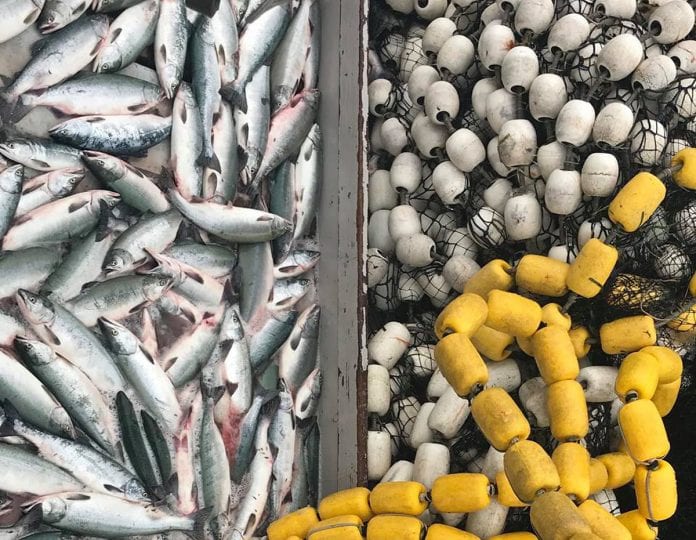
The biggest fish story for Alaska’s salmon season so far is the early plug of pinks at the South Alaska Peninsula.
By June 28, over 8 million pink salmon were taken there out of a statewide catch of just over 8.5 million. Previously, a catch of 2.5 million pinks at the South Peninsula in 2016 was the record for June and last year’s catch was just 1.7 million managers at the Alaska Department of Fish and Game at Sand Point said at this pace, this month’s catch could near 10 million pinks.
“It’s unheard of, really,” ADF&G’s Elisabeth Fox told KDLG radio.
Typically, pink salmon return to the South Pen region in July and managers believe the earlier arrivals are not homing in on local streams.
“We don’t know where these pinks are going,” Fox said.
No tagging studies have been done on the pinks passing through, but they could be headed further north to Norton Sound where record numbers also have shown up for the past few years.
“There is no known link between South Peninsula pinks and Norton Sound,” Jim Menard, area manager for ADF&G in Nome, told SeafoodNews.com.
You can track Alaska’s daily salmon catches by region and species with ADF&G’s Blue Sheet. There are also in-season summaries that graph the weekly progression of commercial salmon harvests and compare it with five year averages.
Pink pressure
All those pink salmon could face stiff headwinds from Russia in global markets. Alaska projects a total catch of nearly 138 million pinks this summer, 97 million more than last year, and Russian fleets expect another huge haul.
“If Alaska and Russia both realize their forecasts it will be interesting to see how the market reacts,” said economist Garrett Evridge with the McDowell Group.
Just how big might Russia’s pink salmon catch be?
“Russia is anticipating a harvest in line with last year which was a record. It was over one billion pounds,” Evridge said. “For context, in 2018 Alaska harvested about 150 million pounds.”
Speaking of Russia – we’re into the fifth year of an embargo that Russia put on US seafood and other food purchases in 2014 to retaliate for alleged US meddling in Ukraine affairs.
That‘s been an annual loss of over $60 million to Alaska, mostly for salmon roe sales to Russia which had grown by 222 percent in 2013, according to the Alaska Seafood Marketing Institute.
Meanwhile, the U.S. continues to buy increasing amounts of seafood from Russia, mostly king crab, snow crab and sockeye salmon. Trade data show the US bought $51 million of Russian-caught seafood in 2018.
Dunleavy déjà vu
On Friday, Governor Dunleavy cut an additional $444 million from Alaska’s state operating budget. All the amendments that the Legislature had added back into the original Fish and Game budget were vetoed.
There is a gag order on fisheries staff at ADF&G and no one is allowed to talk about the budget cuts. All questions are referred to “the governor’s administration.”
United Fishermen of Alaska provided this initial breakdown:
- $997,000 less for commercial fisheries management
- 50 percent reduction in funds for travel across all divisions (including Commercial Fisheries)
- $280,000 less for special areas management
- Transfer of two director-level positions and associated funding from the Division of Habitat and Division of Subsistence Research to the Office of Management and Budget. (these jobs will no longer be associated with Fish & Game related duties)
Shuckin’ time
One of Alaska’s most exclusive fisheries got underway on July 1 – weathervane scallops. Just two boats take part in the fishery which spans from Yakutat to the Bering Sea.
“It’s not something you can get into easily,” said Nat Nichols, area shellfish manager at ADF&G in Kodiak. “It takes a fair bit of institutional knowledge and also specialized gear. Lots of people have some Tanner crab pots lying around but not many have a 15-foot New Bedford scallop dredge in their back yards.”
The scallop fishery also is very labor intensive as it includes crews of up to 12 people who catch and shuck the catch.
“Every Alaska scallop you’ve ever seen was shucked by hand,” Nichols said.
This year the two boats will compete for 267,000 pounds of shucked meats, which are the adductor muscle that keeps the shells closed. They are a wildly popular delicacy and can pay fishermen $6 to $10 a pound, depending on size and grade.
Scallop boats drop big dredges that make tows along mostly sandy bottoms of strictly defined fishing regions. The fishery is co-managed with the federal government and has 100 percent observer coverage. It takes a scallop around five years to be large enough to retain in the fishery.
Weathervane scallops are the largest in the world and their shells can measure 8 to 10 inches across.
Get thee to a DMV!
A request by United Fishermen of Alaska to postpone a new state title and registration law that requires fishing vessels, tenders, barges and sport fish boats to register at the Deparment of Motor Vehicles was denied by Department of Administration’s Commissioner Kelley Tshibaka.
Here’s the breakdown from the Commercial Fisheries Entry Commission:
- Undocumented vessels without a valid certificate of documentation issued by the U.S. coast guard must continue to be registered with the DMV and now must ALSO be titled with the DMV.
- Documented vessels with a valid certificate of documentation issued by the USCG now must ALSO be registered with the DMV. Federally documented vessels are exempt from the new title requirements but are no longer exempt from the DMV registration requirement.





